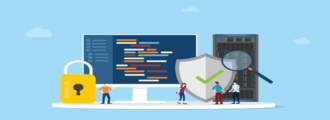Are you prepared for your enterprise resource planning (ERP) system to get hacked?
Your answer could be putting your company at risk.
The consequences of an ERP system breach could be damaging. Think of all the sensitive data it holds—customer and employee information, orders, contracts, and more.
ERP systems consist of some of the most essential functions, such as finances, production, human resources, etc. It’s essentially the operating system for the company. Imagine if it went down.
We see cyberattacks all over the news, but many companies may not understand the risk their ERP systems are to an attack. The first step to strengthening your ERP security is understanding the challenges and building a foundation for cyber hygiene.
This article covers the most common ERP vulnerabilities and outlines best practices to minimize your risk of a breach.
Why Are ERP Systems a Target for Cyberattacks?
First, let’s explain why ERP systems are vulnerable to attacks.
Organizations are implementing ERP systems to reap the benefits of better visibility, customer experiences, and business processes. You can read more about the benefits in our article, Top Benefits of ERP Business Software.
One of the most significant benefits of ERP systems is having a single source of data. But centralized, valuable data is a major target for cybercriminals.
That means a cybercriminal only has to hack one system to gain access to critical data. Threat actors can also exploit ERP infrastructure vulnerabilities by planting malware on a company’s network.
Key Cybersecurity Stats to Know
The cost of a breach is staggering. According to research, cybercrime cost U.S. businesses more than $6.9 billion in 2021. And they’re not just hitting large enterprises. 41% of data breaches now involve small and medium-sized businesses.
Ransomware, phishing, and denial of service attacks are among the most common types of security threats. With ERP systems integrated across many departments, more employees have authorized access, making a company’s attack surface larger.
Most Common ERP Security Challenges
The first step to improving your security posture is to understand the vulnerabilities that exist. And those could be internal and external threats. Here are some of the most common ERP security issues to be aware of.
Unpatched Software Updates
ERP vendors are constantly battling new and emerging security risks. Once these risks are identified, security patches are released for customers to implement. Some businesses are either unaware of the security vulnerabilities or wait too long to patch it.
Time is of the essence because the longer it goes unpatched, the more time cyber attackers have to exploit them. Applying patches and updates for ERP systems need to be implemented quickly and regularly to reduce your company’s risk of outages and downtime.
Lack of Cybersecurity Training
One of the weakest links in security is employees. Many don’t understand how their actions can cause serious risk or damage to the business. That’s why interactive training sessions are vital to maintaining security.
And not just for employees… Your IT teams and security teams need ongoing training to stay on top of the latest ERP security issues.
Poor Incident Response Planning
Many organizations don’t have an incident response plan that outlines how they’ll recover after an ERP system incident. For security best practices, you should have a robust response plan that gets updated regularly. This will prevent your security team from scrambling during a crisis.
One-Factor Authentication
Passwords are the first line of defense against unauthorized access. And weak passwords could be putting your organization at risk. Passwords need to be complex and updated regularly. But some companies are only using one-factor authentication.
To strengthen those password security defenses, multi-factor authentication (MFA) is a must. Multi-factor authentication requires multiple credentials to authenticate a user.
On-Premise vs. Cloud ERP Security
On-premise and cloud-based ERP systems both offer data protection, but they’re managed differently. On-premises ERP systems are managed by the business. Therefore, all maintenance and upgrades are conducted by the business and its IT team. The benefits of on-premise ERP are the control and customizations a company has over its physical systems.
Cloud-based ERP systems are managed by the ERP vendor who sells the technology. That company is responsible for managing updates, security, and hosting the data. Security is an advantage of cloud ERP systems because they typically come with more sophisticated protection, built-in security measures, and 24/7 monitoring of internal and external activity.
Best Practices to Boost Cybersecurity Defenses for ERP Systems
When it comes to cybersecurity, you need to think of it as a “when” it happens, not “if” it happens. The key is prevention and planning techniques. Here are a few security best practices to put into place—today.
- Develop plans for disaster recovery, business continuity, and incident response. Cloud-based ERP tools can help integrate these plans into one place.
- Set up continuous monitoring of your ERP and other systems to improve response.
- Encrypt all your master data and develop robust processes in the areas of patch management, security configuration, vulnerability management, and threat intelligence.
- Conduct thorough ERP testing and replicate the test process to address common threat vectors across the attack surface.
- Implement security policies and training for employees and IT teams.
- Implement strict multi-factor authentication policies and restrict data access to valuable data and systems.
- Conduct regular vulnerability scans and penetration testing to measure how long it takes to spot and respond to attacks.
Preventing ERP Security Threats
When considering a prevention strategy to limit threats to your ERP software, it’s important to consider a few key security parameters and steps in the process…
First, start with a company-wide audit by identifying and ranking all of your ERP security risks. This will help you understand your weaknesses and get you on the path of your ERP security journey.
Next, schedule regular risk assessments and benchmark how you rank against others in your industry. With continuous and automated audits, you’ll see improvements and be able to track long-term goals.
It’s also important to remember that you need to protect yourself from not only external threats, but internal threats as well. Role-based security measures or zero trust strategies ensure sensitive data is only available to a select number of team members.
As the zero trust saying goes, “never trust, always verify.” This method of security protects your ERP data from getting into the wrong hands.
Stay Educated on Cybersecurity Threats
You can also keep your ERP system secure by monitoring threat intelligence. The Cybersecurity and Infrastructure Security Agency (also known as CISA) and major cybersecurity firms are good resources for information on new threats and what to look out for.
This type of threat intelligence should be shared across the company so employees can also be vigilant for malicious cyber activity.
ERP Security Solutions
These have been some of the most challenging times for organizations when it comes to cybersecurity. New threats and vulnerabilities are always emerging, and IT environments are getting increasingly more complex.
A secure ERP solution can give your organization multiple layers of security to protect sensitive data. By having a secure ERP system and deploying a strong cybersecurity plan of action, you’ll be better prepared to defend against the most common threats, like ransomware, malware, and denial of service attacks.
Next Steps to ERP Security
Another way to implement a secure ERP system is to partner with experts. Our team of senior-level ERP consultants is experienced in many ERP systems, including Oracle JD Edwards, SAP, Infor Lawson, Workday, Microsoft Dynamics, and more.
We have the experience and expertise to ensure your ERP is built to meet your company’s needs and improve customer experiences—while maintaining data integrity and keeping your most valuable information secure no matter what.
How Can We Help?
Whether you need help outlining a security plan for your JD Edwards system, assessing data security within SAP, increasing the security of Infor Lawson solutions, making the switch to multifactor authentication in Workday, or anything else related to ERP security, Surety Systems is here to help.
Your company. Your priorities. Our expertise. That’s the name of the game with us.
Contact us today to learn more about our ERP experts and how they can help you improve business operations, eliminate internal risks, and maximize your investments.



